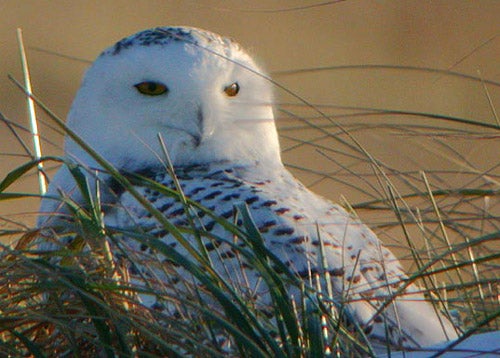SCIENTIFIC NAME:
Bubo scandiacus
STATUS:
Accidental.
DESCRIPTION:
The Snowy Owl is a large and mostly white owl. It has a rounded head with yellow eyes and a black beak. Its feet are covered heavily with feathers. Adult males can be almost solid white with up to three dark tail bands. Females and juveniles are more heavily marked with thin, black horizontal bars and spots. Females can also be distinguished from males because they have four to six dark tail bands. Snowy owls are an average height of 20-27 inches and have a wingspan of 54-65 inches.
DISTRIBUTION:
Snowy owls are known to be circumpolar. Their summer or breeding range is in the high arctic from coastal Alaska across Canada to Labrador. They are also found in Greenland, Iceland, Scandinavia and Russia. During periods of extreme cold weather they winter in southern Canada and northern United States.
HABITAT:
Snowy owls generally stay in the Arctic tundra or open grasslands and fields. Also, they are found along shorelines and gravel beds. They rarely utilize heavily forested areas.
FEEDING HABITS:
Snowy owls are mostly diurnal feeders, feeding from dawn to dusk, but will occasionally hunt at night. The snowy owl is an opportunistic hunter and will eat small mammals, birds, fish and carrion. They are largely dependent on lemmings and voles for food and their population fluctuations coincide with the availability of the aforementioned prey. They often find a perch to locate prey from and fly down and catch it with their talons. Snowy owls are known to raid trap lines and eat small furbearing animals that are caught in the traps. Small prey items are eaten whole while larger prey is torn into chunks. The young are fed torn up pieces of boneless, furless flesh.
LIFE HISTORY AND ECOLOGY:
The snowy owl is known to live to at least nine and one-half years in the wild and up to thirty-five years in captivity. They perform their breeding in May but courtship can begin in March and April. The males bow, fluff their feathers and strut around with their wings spread and dragging the ground to attract a mate. Males often kill and display prey in caches to try to impress a female. When nesting begins, the nest is made by the female and is almost always on the ground, although, they will occasionally use abandoned eagle nests. The nest is a shallow scrape on a mound or rise that is usually lined with vegetation and owl feathers. Nest sites are always near good hunting grounds; they must be snow free and have an unobstructed view of the surrounding area.
Snowy owls only have one brood per year and usually do not re-nest if failure occurs. Females lay an average of 5-8 white eggs but can lay as many as 14 if lemming and vole populations are high. These eggs are laid at two day intervals and are incubated by the female for 32-34 days. The male hunts food and guards the nest while the female is incubating the eggs. After the incubation process the eggs hatch at two day intervals which can lead to large age differences when large clutches are present. The young are solid white and depend on both the male and female to feed them initially. Snowy owls are very territorial when young are present and are known to attack intruders up to .6 miles from the nest location. Young are able to leave the nest after about 25 days but do not fledge until 50-60 days.
REFERENCES:
Boyer and Hume. 1991. Owls of the World. BookSales Inc
Campbell, W. 1994. "Know Your Owls (CD-ROM)". Axia Wildlife
König, W. and Becking. 1999. Owls: A Guide to the Owls of the World. Yale University Press
Long, K. 1998. Owls: A Wildlife handbook. Johnson Books
Mikkola, H. 1983. Owls of Europe. Buteo Books
Voous, K.H. 1988. Owls of the Northern Hemisphere. The MIT Press
Cornell Laboratory of Ornithology.
Peterson, R.T. 1980. Peterson Field Guide (Eastern Birds). Houghton Mifflin Company, Boston, MA.






